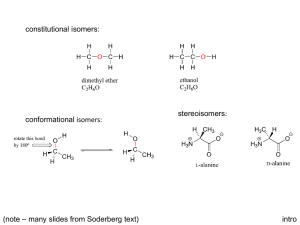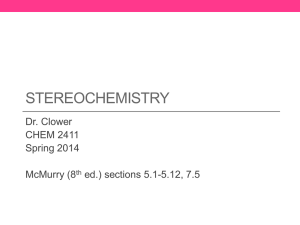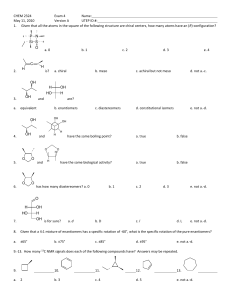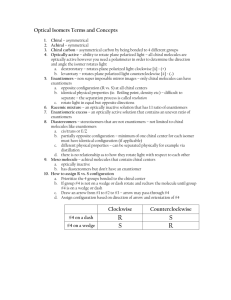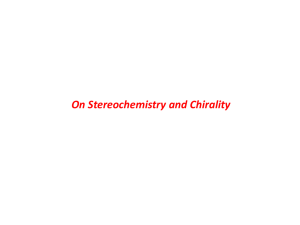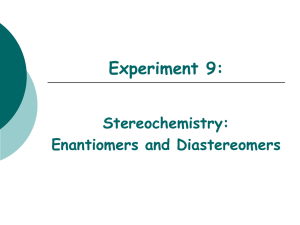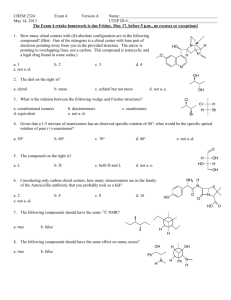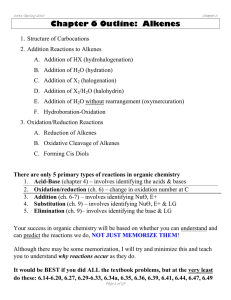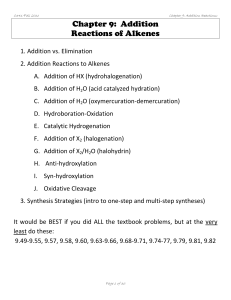1. Chiral & Achiral Compounds
advertisement
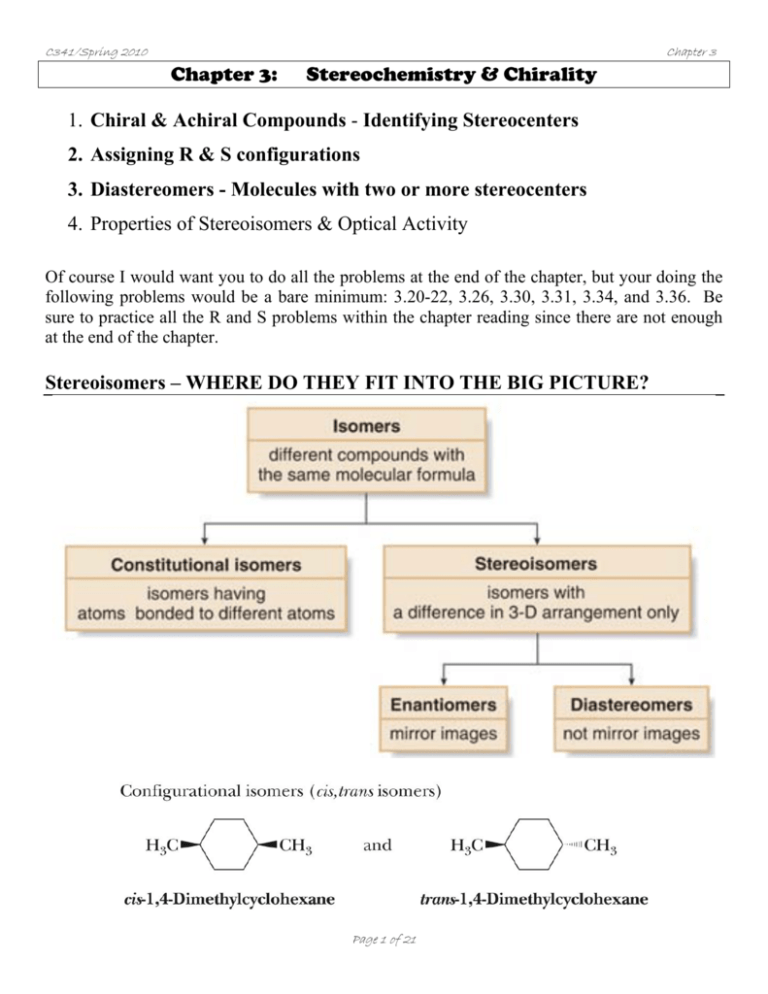
C341/Spring 2010 Chapter 3 Chapter 3: Stereochemistry & Chirality 1. Chiral & Achiral Compounds - Identifying Stereocenters 2. Assigning R & S configurations 3. Diastereomers - Molecules with two or more stereocenters 4. Properties of Stereoisomers & Optical Activity Of course I would want you to do all the problems at the end of the chapter, but your doing the following problems would be a bare minimum: 3.20-22, 3.26, 3.30, 3.31, 3.34, and 3.36. Be sure to practice all the R and S problems within the chapter reading since there are not enough at the end of the chapter. Stereoisomers – WHERE DO THEY FIT INTO THE BIG PICTURE? Page 1 of 21 C341/Spring 2010 Chapter 3 Does stereoisomerism matter chemically? . (R)-limonene Orange smell (S)-limonene Lemon smell Page 2 of 21 C341/Spring 2010 Chapter 3 1. Chiral & Achiral Compounds Chirality is encountered in a host of everyday examples where asymmetry exists: Chiral = molecules that are non-superimposable on their mirror image A simplified rule applies to tetrahedrally-bonded carbon, where all four substituents are different, the carbon is a called stereocenter = chiral center. o If there are two equivalent groups on the same carbon, that carbon CANNOT be a stereocenter. Achiral = a species with no chiral center - achiral compounds have a plane or center of symmetry somewhere… Page 3 of 21 C341/Spring 2010 Chapter 3 We will discuss in a moment that chiral carbons have two forms – R & S Are all molecules chiral? How do you identify a chiral compound? (We will only focus on the chirality around carbon for this discussion.) o The most common cause of chirality in organic molecules is a tetrahedral carbon with 4 different substituents attached to it. o If you find a carbon with four different groups attached to it, it is called a stereocenter, or chiral center. Are the following compounds chiral? (Look for a plane of symmetry/similar groups) O Page 4 of 21 C341/Spring 2010 Chapter 3 Q: Identify all the stereocenters in the following molecules. CHOLESTEROL TAXOL- Taxol, a potent anticancer natural product (with activity against a number of leukemias and solid tumors in the breast, ovary, brain, and lung in humans) was isolated from the bark of the pacific yew in 1971. Page 5 of 21 C341/Spring 2010 Chapter 3 Thalidomide – an example of enantiomers having different properties o Thalidomide was released in 1956 as a mild sedative used to treat nausea in pregnant women. (Withdrawn from the market in 1961 once it was discovered thalidomide was a human teratogen.) o As little as one dose could cause a significant birth defect. o Over 10,000 infants were born with birth defects to women who ingested thalidomide during pregnancy. o In 1998, it was rereleased for leprosy selling over $300M in sales. Aspartame® is a sweetening agent (Equal) that is more than a 180 times sweeter than sucrose. Only the R-enantiomer is desired as the S-enantiomer does not have the correct shape to fit the binding site of the 'sweetness' receptors on the tongue. Neotame (NutraSweet) is between 7,000-13,000 times sweeter than sucrose. Aspartame Neotame Page 6 of 21 C341/Spring 2010 Chapter 3 So, how common is chirality? Chirality in your everyday life… Ibuprofen o R – enantiomer is relatively “inactive” in the body o S – enantiomer is 160 times more active as a pain killer! Naproxen Sodium Page 7 of 21 C341/Spring 2010 Chapter 3 Let’s practice drawing mirror images and testing for superimposability Page 8 of 21 C341/Spring 2010 Chapter 3 2. Assigning R & S stereocenters A. Assign priority to the four atoms attached to the stereocenters. a. Each atom is assigned a priority based on atomic number. Heavier isotopes get higher priority. b. If priority cannot be assigned based solely on atomic number, then look at the next atom attached. Priority is assigned by the first point of difference. c. Atoms participating in multiple bonds are considered to be bonded to the equivalent number of similar atoms by a single bond. B. Orient the molecule in space so that the lowest priority is directed away from you. C. “Read” the groups projected toward you in order from highest to lowest. • Groups in a clockwise fashion → R (R stands for Latin, rectus = correct) • Groups in a counterclockwise fashion → S (S stands for Latin sinister = left) Page 9 of 21 C341/Spring 2010 Chapter 3 Practice assigning R or S configurations: O O OH OH OH OH OCH 3 Cl Cl OH OH OH O Page 10 of 21 C341/Spring 2010 Chapter 3 Practice assigning R or S configurations: What if the 4th priority is IN the plane of the paper? Then what do you do? F F NH2 NH2 More practice: O COOH * Ketoprof en Page 11 of 21 H C341/Spring 2010 Chapter 3 3. Diastereomers -- Molecules with TWO or MORE stereocenters “How many different configurations can one obtain with more than one chiral center in a molecule?” o The possible number of stereoisomers for any molecule is . Chymotrypsin – digestive enzyme found in intestines and secreted by the pancreas of mammals that catalyze the hydrolysis of proteins during digestion. 251 o It has 251 stereocenters, with 2 possible stereoisomers! But only one is synthesized and utilized in mammals! Diastereomer = stereoisomers that are not enantiomers (mirror images of each other). Diastereomers are pairs of isomers that have opposite configurations at one or more of the chiral centers but are not mirror images of each other. Diastereomers can have different physical properties and different reactivity. Page 12 of 21 C341/Spring 2010 Chapter 3 Fischer Projections Fischer projections are used usually when molecules have more than one chiral center in the backbone. They impart three dimensional information in a two dimensional method. o A & B are o C & D are o A & C, A & D are o B & C, B & D are Page 13 of 21 C341/Spring 2010 Chapter 3 Q: Assign an R or S configuration to each stereocenter and determine the relationships between them. Page 14 of 21 C341/Spring 2010 Chapter 3 How many stereoisomers do you expect for the following molecule? How many enantiomers and how many diastereomers? CHO H Cl H Br H OH CH3 Page 15 of 21 C341/Spring 2010 Chapter 3 What if a molecule has a plane of symmetry in one stereoisomer? Meso Compounds = For example: CH 3 H Br CH 3 1 CH 3 CH 3 Br H Br Br H H Br H CH 3 CH 3 3 2 Page 16 of 21 CH 3 H Br H Br Br H CH 3 4 C341/Spring 2010 Chapter 3 How many stereoisomers exist for the following molecules? Page 17 of 21 C341/Spring 2010 Chapter 3 Draw an enantiomers or diastereomer for the following compounds: Cl Br Page 18 of 21 C341/Spring 2010 4. Chapter 3 Properties of Stereoisomers & Optical Activity Are enantiomers identical in physical properties? Can you ever tell them apart when you prepare them? o Enantiomers have identical physical properties, i.e. the same melting point, boiling point, and solubility in standard solvents. o Diastereomers do have different properties since they may have different dipole moments and different IMF. Page 19 of 21 C341/Spring 2010 Chapter 3 Optical Activity One property that DOES exist that is different between enantiomers is their “optical activity”. (Discovered in 1811 by Francois Arago and Jean Baptiste Biot). Enantiomers rotate polarized light in equal but opposite directions. Polarimeter: Optical Activity Specifics o Light source is usually λ = 589 nm, called the sodium-D line. o If the analyzer tube is rotated to the right to restore darkness, then the compound is given a d-designation (Latin, dexter, on the right side) o If the analyzer tube is rotated to the right to restore darkness, then the compound is given a l-designation (Latin, laevus, on the left side) o A racemic mixture (50/50 mixture) of enantiomers has no rotation; unequal mixtures of enantiomers have rotations between the rotation of one pure enantiomer and zero. Page 20 of 21 C341/Spring 2010 Chapter 3 When chemists run a reaction, do they always end up preparing a mixture that is 50:50 mixture of each enantiomer? Racemic mixture = Enantiomeric Excess (ee) = Enantiomeric excess (ee) is a way to describe the product composition of a mixture of enantiomers: ee% = (larger amount - smaller amount) x 100% (R + S) What is the ee% of a reaction that has 88% S and 4% R products? Page 21 of 21

